Sauropodomorpha: Sauropoda
Taxa on This Page
- Barapasaurus X
- Cetiosauridae X
- Eusauropoda X
- Haplocanthosaurus X
- Jobaria X
- Mamaenchisauridae X
- Neosauropoda X
- Sauropoda X
- Vulcanodontidae X
Descriptions
Sauropoda:
Introduction: The sauropods are the gigantic long-necked plant-eating dinosaurs, and include such well-known names as Apatosaurus ("Brontosaurus"), Brachiosaurus, Cetiosaurus, and Diplodocus, as well as numerous other species and genera. They were the largest of all land animals, and among the most successful and long-lived of the dinosaurs. The earliest known species, the small Vulcanodon (6 1/2 metres) dates back to the Sinemurian epoch, while the latest include a number of species such as the small Titanosaurus indicus and Hypselosaurus priscus (lengths about 12 metres), and the large Alamosaurus sanjuanensis (20 metres), were still flourishing right up until the terminal Cretaceous extinction. It was at one time thought on the basis of the North American fossil record) that the sauropods became rare after the Late Jurassic, but in most parts of the world they continued as a common element of the megafauna until the very end of the Cretaceous. Throughout their long history they continued to evolve and branch out new species and families. There are at least three peaks of sauropod diversity in the Late Jurassic, late Early Cretaceous and latest Cretaceous, corresponding to high sea levels and increased speciation resulting from geographical isolation.
Sauropods were long believed to be semi-aquatic swamp wallowers, relying on the bouyancy of water to support their massive bodies. But analysis of their skeletons, in comparison with those of large terrestrial and semi-aquatic animals, and of sedimentation where their fossils have been found, show that sauropods were fully terrestrial:
"The deep thorax of sauropods is an adaption to problems of terrestrial weight-bearing. Sauropod foot and limb structure is generally comparable to elephants...(S)edimentological evidence does not suport immersion in deep lakes as....frequently pictured..."
[Walter Coombs, p.1]
Not only were sauropods as terrestrial as elephants, but fossil trackways indicate that they lived in herds, again like elephants today. It must have been a truely awesome sight to watch a herd of brontosaurs crossing a Mesozoic floodplain; evoking the same sense of awe, and puniness in one's own being in comparison, as one would feel when observing whales close up.
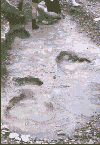 The Sauropoda include the largest animals ever to walk on land. These gigantic herbivores reaches lengths of 15 to 25 metres or more (the very largest may have reached 45 metres) and weights of 15 to 30 or even 50 or 60 tonnes. Previous estimates of 87 to 150 tonne animals are unrealistic and physiologically impossible. No sauropod ever equalled in size the greatest of the baleen whales.
The Sauropoda include the largest animals ever to walk on land. These gigantic herbivores reaches lengths of 15 to 25 metres or more (the very largest may have reached 45 metres) and weights of 15 to 30 or even 50 or 60 tonnes. Previous estimates of 87 to 150 tonne animals are unrealistic and physiologically impossible. No sauropod ever equalled in size the greatest of the baleen whales.
Sauropods were superbly adapted creatures, the Mesozoic equivalent of the elephant. They had an advanced (not a lizard-like) metabolism, inhabited every continent and continued to evolve and diversify right up until the terminal Mesozoic extinction. It has been suggested that they were cold-blooded like conventional reptiles; that they could not possibly have been endothermic, because they were too big to eat enough food to fuel their bodies. This argument falls apart when you realise most weight estimates have been overstated. An analysis of the load-bearing capacity of Giraffatitan "Brachiosaurus") brancai limb bones show that this creature could only have weighed 15 tonnes, not the 50 to 80 tonnes that had previously been estimated Russell et al. (1980). Combine that with a huge stomach full of gastric stones (giving a food-grinding ability greater than any elephant's) and a gut full of symbiotic bacteria, and the possibility they were at least partially endothermic is not too unreasonable. Whether they had the full endothermy of birds, mammals, or small theropod dinosaurs is another question. The most likely explanation is that (and this would be true of most large dinosaurs) they started out as active fully endothermic youngsters and settled down into a gigantothermic metabolism as they approached adult size.
There are currently eight valid families of sauropods: Vulcanodontidae, Cetiosauridae, Brachiosauridae, Camarasauridae, Diplodocidae, Euhelopodidae, Dicraeosauridae and Titanosauridae. However, this is certainly an underdestimate of the true diversity of these amazing beasts. Ironically, despite their great size (which would one would think would enable more frequent preservation of remains) the fossil record is quite poor, perhaps due to the large skeletons being skattered before sediment settles to cover them. Most sauropod remains are actually scattered and isolated bones and teeth.
Characters: Very large (7-40 m), quadrupedal herbivorous forms; small head; blunt teeth; nares located high up on the skulls close to orbits; very long neck; long tail; caudal transverse processes dorsoventrally expanded [S+05]; erect, graviportal elephant-like limbs; digits 5/5; some with partial body armor.
Links: DinoData: Sauropoda; Sauropoda; sauropoda cladogram; Basal Sauropoda; Sauropods - Paleontology and Geology Glossary; ?????? Sauropoda; Witmer's Lab Dinosaur Skull Collection: Sauropoda; Literature - Sauropoda; The Natural History Museum's Dino Directory; Sauropodomorpha; sauropoda.
References: Russell et al. (1980); Salgado et al. (2005) [S+05].
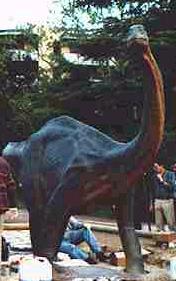 Vulcanodontidae:Chinshakiangosaurus, Kunmingosaurus, Ohmdenosaurus, Vulcanodon, Zhigongosaurus. Very early sauropods.
Vulcanodontidae:Chinshakiangosaurus, Kunmingosaurus, Ohmdenosaurus, Vulcanodon, Zhigongosaurus. Very early sauropods.
lwJ (& upT?) of Afr & China(?).
Introduction: Vulcanodon karibaensis Raath 1972
Vulcanodon beds, Mashonaland North, Zimbabwe
Partial skeleton 6 meters long, missing neck and head
Estimated total length around 8 metres; Weight several tonnes
Lifestyle: Very large terrestrial herbivore
Age: Sinemurian
Vulcanodon is the most primitive known sauropod dinosaur, and retains a number of prosauropod features. Yet some of the characteristics of the skeleton, such as the pubis, are anatomically more advanced than in larger and later sauropods like Barapasaurus. This is a good example of what is called "mosaic" evolution, the presence of both primitive and advanced characteristics within transitional organisms (Archaeopteryx is a good example of this, displaying both theropod ("prmitive") and bird ('advanced") characteristics.)
Somewhat contradictory dates have been given for the "Vulcanodon Beds". Although reported from the earliest Jurassic, close to the Triassic boundary (i.e. early Hettangian), pollen analysis indicates a date no older than the Sinemurian, and possibly younger. Olsen & Sues (1986). I have tentatively dated Vulcanodon as Sinemurian. In any case it seems that the Vulcanodontids and their descendents quickly supplanted the Plateosaurs as large terrestrial herbivores, 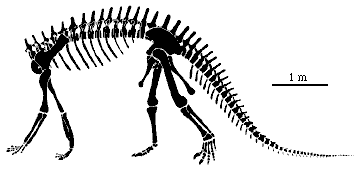 although smaller prosauropods continued up until the Toarcian.
although smaller prosauropods continued up until the Toarcian.
Kunmingosaurus wudingensis Zhao, 1985
nearly complete skeleton
Overall length: 6 metres
Chinshakiangosaurus zhongheensis Yeh, 1975
fragmentary skeleton
Overall length: ?12 - ?13 metres
Reference is made to a sauropod dinosaur from the Wudin basin in Yunnan, China. Although the horizon is thought equivalent to the adjacent famous prosauropod-dominated Lower Lufeng formation (Hettangian), there is no evidence for sauropods in the Lufeng beds [A.L.Sun and K.H.Cui, "The Lower Lufeng Saurischian fauna", p.278, and Peter M. Galton, "Herbivorous adaptions of dinosaurs, p.208; in The Beginning of the Age of Dinosaurs, ed. K.Padian] and it is likely that Kunmingosaurus and Chinshakiangosaurus comes from a later period, perhaps close in time to Vulcanodon. A Sinemurian age is tentatively suggested.
Ohmdenosaurus liasicus Wild, 1978
Posidonienschiefer, Baden-Wurttemberg, Germany
Age: Middle Toarcian
Limb bone
Estimated overall length: 4 metres
This very small, primitive sauropod is known only from a single limb bone, once thought to belong to a plesiosaur. Although classified under the family Vulcanodontidae it may instead belong to a distinct group, which might be called family Ohmdenosauridae. It had no clear descendents, and may have been one of the many types of dinosaur that were wiped out by the terminal Toarcian extinction event. (MAK 991228)
5-10 m long, 2m at shoulder. Moderately long neck; 3 or 4 sacrals; unspecialized pelvis, with somewhat prosauropod-like "apron" actually plesiomorphic per Upchurch 1995)); pleurocoels absent; femur retains inner trochanter; reduced metatarsal V (a prosauropod character); columnar limbs; gastroliths known.
Links: DinoData: Vulcanodontidae; dml dinov; sauropoda; Lecture 12 - Early Jurassic.
References: Galton (1986); Olsen & Sues (1986); Sun & Cui (1986); Upchurch (1995), Upchurch (1998).
Note: This is almost certainly not a clade. However, following the suggestion of Upchurch 1998), this group is retained to describe the earliest (probably late Triassic) sauropod radiation. Kotasaurus, from the Jurassic of India, may represent an even more primitive type. At the moment, Vulcanodon consists of a pelvic region, some forelimb bones, and some other odd bits. Barapasaurus, which is separately listed below, is some very partial and disarticulated pieces of several individuals. The Chinese species are even scrappier. Thus, it is hard to say who really belongs with whom at the moment.
Image: sculpture of Vulcanodon © Tridimont and reproduced by permission. 000517
Barapasaurus: may include, or anchor a family including, Kotasaurus.
Range: Early Jurassic of India
Phylogeny: Sauropoda :: Eusauropoda + *.
Introduction: Barapasaurus tagorei Jain, Kutty, Roy-Chowdhury, & Chatterjee, 1975
Kota Formation, Andhra Pradesh, India
Length: 14.5 to 18 metres; Weight: 13 to 25 tonnes
Remains of 6 partial skeletons (missing skull & feet)
Toarcian
The first of the really big sauropods, Barapasaurus equalled in size the giants of the later Jurassic. In structure, however, it was much more primitive, resembling Vulcanodon in many features of the skeleton. As befits its transitional nature, it is sometimes included under the Vulcanodontidae, sometimes under the Cetiosauridae, and sometimes in its own family. Barapasaurus is another example of "mosaic evolution" among transitional forms. According to the Argentine palaeontologist Jose Bonaparte the dorsal vertebrae of Barapasaurus are of the standard Cetiosaur grade, with a tall neural arch and zygapophyses far above the neural canal; much more advanced the vertebrae of Vulcanodon Bonaparte (1986).
Kotasaurus yamanpalliensis Yadagiri, 1988
Kota Formation, Andhra Pradesh, India
Length: 6 metres
partial skeletons
Toarcian MAK 991228)
Eusauropoda:
Characters: snout with stepped, shelf-like subnarial margin; retraction of external nares; ascending process of maxilla meets lacrimal; external mandibular fenestra extends below orbits; short skull roof and temporal region; anterior part of lower temporal fenestra extends under orbits; $ loss of denticles on tooth crowns; teeth procumbent; teeth anterior to or below antorbital fenestra; extensive pneumatization of vertebrae; 12+ cervical vertebrae; $ transverse processes of dorsal vertebrae directed dorsolaterally; forked chevrons ?); graviportal stance, with metacarpals arranged in semicircular collonade; manus phalangeal formula 2-2-2-2-1 or less; pubes short, robust & not twisted; $ 4th trochanter reduced to low, rounded ridge; metatarsal I short & robust; $ length of metatarsal V 85% or more length of metatarsal IV; loss of ligament pits (?) on toes; pes IV with 3 phalanges.
Links: Basal Sauropoda; Sauropoda -- The Dinosauricon; Atlasaurus imelakei; The Evolution of Dinosaurs; sauropoda; Re: Triassic Sauropods (Cretaceous ones meanwhile); Sauropodomorpha; Re: Details on Huaibasaurus; SAUROPODOMORPHS October 1) (Best on the Web). ATW020716.
 Mamenchisauridae: =Euhelpodidae?): Mamenchisaurus, Hudiesaurus. Unclear whether this group should include more primitive Chinese sauropods (Shunasaurus, Omeisaurus), but treated here as a separate family.
Mamenchisauridae: =Euhelpodidae?): Mamenchisaurus, Hudiesaurus. Unclear whether this group should include more primitive Chinese sauropods (Shunasaurus, Omeisaurus), but treated here as a separate family.
Introduction: This lineage culminates in the 22 meter Mamenchisaurus, which has the longest neck of any animal. Mamenchisaurids have been drawn like dinosaurian giraffes, with the head held high in the air. In fact - as with the barosaurs and brachiosaurs - this pose is physiologically impossible. There is no way in which the heart could of pumped blood to the head against the force of gravity. A more reasonable explanation is that the neck was held stiffly in front of the body, and swung from side to side as the creature grazed on ferns and other plants. (MAK 000508)
Skull taller, blunter than diplodocids; broad se (on both sides), spatulate teeth, not confined to anterior jaw; longest known neck, up to 12 m (of about 22m overall length), with 19 vertebrae also a dinosaur record); neck vertebrae ventrally braced by elongated, neck supported by interlocked cervical ribs under the cervical vertebrae extending caudally up to 3 vertebrae; vertebrae cleft in pectoral region; vertebrae highly pneumatized; forked tail chevrons (beginning at caudal #12); front and hind limbs almost equal (or hindlimbs longer than forelimbs?); limbs similar to camarasaurids.
Links: DinoData: Mamenchisaurus; Re: Euhelopodidae and Mamenchisauridae; Euhelopodidae; Dinosauria Translation and Pronunciation Guide H (entry for Hudiesaurus); Mamenchisaurus - Dinosaur - Enchanted Learning Software; DGF, Geological Society of Denmark, Geologisk Tidsskrift Nr. 2, 1996 (see last abstract on page); Mamenchisaurus; FPDM : Mamenchisaurus hochuanensis; Mamenchisaurus; Mamenchisaurus; Untitled Document; Mamenchisaurus Portuguese); Mamenchissauro Portuguese); China 2000; Bienvenue chez Nicolas , Futur Paléontologue (French);
Note: As with most dinosaurs, mass estimates for Mamenchisaurus have recently been significantly reduced: in this case from 55,000 to perhaps 30,000 kg. (ATW 011219).
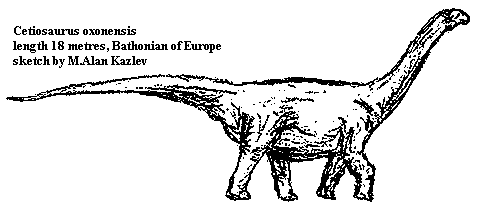 Cetiosauridae:
Cetiosauridae:
Introduction: This lineage includes some of the most primitive of the great sauropods. Some forms, like Shunosaurus, still retained many prosauropod features. Yet even at this early evolutionary stage they had already become specialised, some developing ankylosaurid-like clubbed tails as protection against predators (and maybe also a sexual display device) (MAK
000508)
Teeth broad; simple vertebral spines on neck and trunk; middle chevrons forked as in Diplodocidae; bony club at end of tail in some species.; fibro-lamellar bone (indicative of fast growth) known from Cetiosaurus.
Links: DinoData: Cetiosauridae; Sibbick's dinosaur pictures.
Haplocanthosaurus:
Range: Late Jurassic of North America
Phylogeny: Eusauropoda ::: (Jobaria + Neosauropoda) + *.
Introduction:
Haplocanthosaurus priscus Hatcher 1903
syn H. utterbacki, Haplocanthus)
Morrison Formation; Colorado and Wyoming, United States
Late Kimmeridgian
2 partial skeletons lacking skulls
Length: 13 metres; Weight about 5 tonnes
This smallish sauropod was unusual in that it was a survivor of the very primitive Cetiosaurid line, existing as a sort of "living fossil" alongside its more advanced descendants. It probably should be grouped with Cetiosaurus, which it resembles, in the family Cetiosauridae, although Jose Bonaparte (1986) argues it should be placed in a distinct family because of its unusual and more advanced vertebral structure. Perhaps implausably, Bonaparte classes Haplocanthosaurus with Dicraeosaurus - which shows a similiar vertebral form but is otherwise a very different type of sauropod - in the Dicraeosauridae. The upper spine of each vertebra was single, not forked as in most sauropods. Lambert 1983). Haplocanthosaurus resembled Brachiosaurus in its high shoulders, fairly long neck, and short tail, but this was the result of parallel evolution and adaptation to a giraffe-like high-feeding lifestyle, not direct relationship. The back was quite long, containing 14 vertebrae.
Haplocanthosaurus delfsi McIntosh et Williams 1988
Morrison Formation; Colorado, United States
Middle Tithonian
Partial skeleton lacking skull
Length: 21.5 metres; Weight about 25 tonnes
A huge and rare Haplocanthosaur, the last and one of the largest of the Cetiosaurids. Although "Cetiosaurus" has supposedly been reported from the Early Cretaceous of England, those isolated post-crania would actually belong to other sauropods of that time. It seems that this family, once so successful and widespread, did not survive the mid-Tithonian extinction. (MAK 000218)
References: Bonaparte 1986), Lambert (1983).
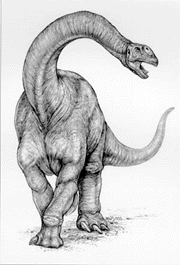 Jobaria: 18 m primitive sister taxon of all eusauropods.
Jobaria: 18 m primitive sister taxon of all eusauropods.
Spoon-shaped teeth; short neck with 12 cervicals; cervical vertebra bearing prezygapophyses with accessory anterior process; cervical ribs 3-6 with accessory anterior spine; dorsal prezygapophyses with broad pendant flange; dorsal neural arches with fossa between para- and diapophyses; U-shaped 1st chevron; mid-caudal chevrons with rugose ridge across distal end of blade.
References: Sereno 1999); Sereno et al. 1999). 010524.
Neosauropoda: Definition: Saltasaurus + Diplodocus, that is the last common ancestor of titanosaurs and diplodocids and its descendants.
Middle Jurassic to Late Cretaceous.
Characters: $ teeth concentrated at front of jaw; sacral ribs 3-5 fused tightly to acetabulum and participating in articular surface [S+05]; $ pillar-like metacarpals, with elevation of the metacarpus from a plantigrade to digitigrade posture.
Links: neosauropoda cladogram; Untitled Document; The Evolution of Dinosaurs; Wilson & Sereno's Sauropod Phylogeny; Sauropodomorpha brief discussion); Euhelopodidae recent changes in the tree); EVOLUTION OF HERBIVORY, NECK ELONGATION, AND LOCOMOTION IN ... important abstract: Neosauropoda is the end of basic sauropod specialization and beginning into divergence based on either limb [Macronaria] or dental [Diplodocoidea] specialzations) Untitled Document (abstract of Wilson & Sereno, 1998); GEOL 104 Lecture 21- Sauropodomorpha- Size matters brief discussion).
References: Salgado et al. (2005) [S+05]. ATW051102.
 The Sauropoda include the largest animals ever to walk on land. These gigantic herbivores reaches lengths of 15 to 25 metres or more (the very largest may have reached 45 metres) and weights of 15 to 30 or even 50 or 60 tonnes. Previous estimates of 87 to 150 tonne animals are unrealistic and physiologically impossible. No sauropod ever equalled in size the greatest of the baleen whales.
The Sauropoda include the largest animals ever to walk on land. These gigantic herbivores reaches lengths of 15 to 25 metres or more (the very largest may have reached 45 metres) and weights of 15 to 30 or even 50 or 60 tonnes. Previous estimates of 87 to 150 tonne animals are unrealistic and physiologically impossible. No sauropod ever equalled in size the greatest of the baleen whales.
 although smaller prosauropods continued up until the Toarcian.
although smaller prosauropods continued up until the Toarcian.

